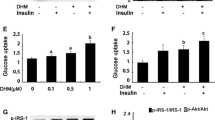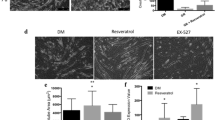Abstract
Previous studies have shown that hyperinsulinemia is not only a marker of insulin resistance, but also the causative factor of peripheral tissue insulin resistance. It also has been suggested that prolonged high-dose insulin treatment can mimic the effects of hyperinsulinemia and exacerbate insulin resistance in skeletal muscle cells. However, how to prevent or reverse insulin resistance induced by hyperinsulinemia remains largely unclear. In the past few decades, the use of myricetin as an anti-diabetic agent has gained much attention, but little information is available regarding the effects of myricetin on glucose uptake and hyperinsulinemia-induced insulin resistance in skeletal muscle cells. The present study focuses on the effect of myricetin on insulin signaling in skeletal muscle cell line C2C12 myotubes. Initially, the effect of myricetin under normal condition was determined. We found that myricetin’s enhancement in glucose uptake coincided with both protein kinase B (Akt) and AMP-activated protein kinase (AMPK) activities. After that, the role of hyperinsulinemia was investigated. It was showed that prolonged high-dose insulin treatment inhibited both Akt and AMPK activities. As the results, the low-dose insulin stimulation of glucose uptake was inhibited by hyperinsulinemia. However, the treatment of myricetin improved low-dose insulin-stimulated glucose uptake in the hyperinsulinemic state, and this effect essentially depended on the AMPK signal pathway. Together, our data suggest a putative link between hyperinsulinemia and insulin resistance in C2C12 myotubes, and the myricetin treatment stimulates glucose uptake and attenuates insulin resistance.






Similar content being viewed by others
References
Weyer C, Hanson RL, Tataranni PA, Bogardus C, Pratley RE (2000) A high fasting plasma insulin concentration predicts type 2 diabetes independent of insulin resistance. evidence for a pathogenic role of relative hyperinsulinemia. Diabetes 49:2094–2101
Dankner R, Chetrit A, Shanik MH, Raz I, Roth J (2009) Basal-state hyperinsulinemia in healthy normoglycemic adults is predictive of type 2 diabetes over a 24-year follow-up. Diabetes Care 32:1464–1466
Morrison JA, Glueck CJ, Umar M, Daniels S, Dolan LM, Wang P (2011) Hyperinsulinemia and metabolic syndrome at mean age of 10 years in black and white schoolgirls and development of impaired fasting glucose and type 2 diabetes mellitus by mean age of 24 years. Metabolism 60:24–31
Kanety H, Moshe S, Shafrir E, Lunenfeld B, Karasik A (1994) Hyperinsulinemia induces a reversible impairment in insulin receptor function leading to diabetes in the sand rat model of non-insulin-dependent diabetes mellitus. Proc Natl Acad Sci USA 91:1853–1857
Shafrir E (1996) Development and consequences of insulin resistance: lessons from animals with hyperinsulinaemia. Diabetes Metab 22:122–131
Ueno M, Carvalheira JBC, Tambascia RC, Bezerra RMN, Amaral ME, Carneiro EM, Folli F, Franchini KG, Saad MJA (2005) Regulation of insulin signalling by hyperinsulinaemia: role of IRS-1/2 serine phosphorylation and the mTOR/p70 S6K pathway. Diabetologia 48:506–518
Shanik MH, Xu Y, Skrha J, Dankner R, Zick Y, Roth J (2008) Insulin resistance and hyperinsulinemia. Is hyperinsulinemia the cart or the horse? Diabetes Care 31(Suppl. 2):S262–S268
Pirola L, Bonnafous S, Johnston AM, Chaussade C, Portis F, Obberghen EV (2003) Phosphoinositide 3-kinase-mediated reduction of insulin receptor substrate-1/2 protein expression via different mechanisms contributes to the insulin-induced desensitization of its signaling pathways in L6 muscle cells. J Biol Chem 278:15641–15651
Gonzaleza E, Fliera E, Mollea D, Accilib D, McGrawa TE (2011) Hyperinsulinemia leads to uncoupled insulin regulation of the GLUT4 glucose transporter and the FoxO1 transcription factor. Proc Natl Acad Sci U S A 108:10162–10167
DeFronzo RA, Jacot E, Jequier E, Maeder E, Wahren J, Felber JP (1981) The effect of insulin on the disposal of intravenous glucose. Results from indirect calorimetry and hepatic and femoral venous catheterization. Diabetes 30:1000–1007
Saltiel AR, Kahn CR (2001) Insulin signaling and the regulation of glucose and lipid metabolism. Nature 414:799–806
Kraegen EW, Bruce C, Hegarty BD, Ye JM, Turner N, Cooney GJ (2009) AMP-activated protein kinase and muscle insulin resistance. Front Biosci 14:4658–4672
Hayashi T, Hirshman MF, Kurth EJ, Winder WW, Goodyear LJ (1998) Evidence for 5′ AMP-activated protein kinase mediation of the effect of muscle contraction on glucose transport. Diabetes 47:1369–1373
Harnly JM, Doherty RF, Beecher GR, Holden JM, Haytowitz DB, Bhagwat S, Gebhardt S (2006) Flavonoid content of US fruits, vegetables, and nuts. J Agric Food Chem 54:9966–9977
Mendez J, Bilia AR, Morelli I (1995) Phytochemical investigations of Licania genus. Flavonoids and triterpenoids from Licania pittieri. Pharm Acta Helv 70:223–226
Barbosa-Filho JM, Vasconcelos THC, Alencar AA, Batista LM, Oliveira RAG, Guedes DN, Falcao HS, Moura MD, Diniz MFFM, Modesto-Filho J (2005) Plants and their active constituents from South, Central, and North America with hypoglycemic activity. Rev Bras Farmacogn 15:392–413
Knekt P, Kumpulainen J, Jarvinen R, Rissanen H, Heliovaara M, Reunanen A, Hakulinen T, Aromaa A (2002) Flavonoid intake and risk of chronic diseases. Am J Clin Nutr 76:560–568
Ong KC, Khoo HE (2000) Effects of myricetin on glycemia and glycogen metabolism in diabetic rats. Life Sci 67:1695–1705
Liu IM, Liou SS, Lan TW, Hsu FL, Cheng JT (2005) Myricetin as the active principle of Abelmoschus moschatus to lower plasma glucose in streptozotocin-induced diabetic rats. Planta Med 71:617–621
Liu IM, Tzeng TF, Liou SS, Lan TW (2007) Myricetin, a naturally occurring flavonol, ameliorates insulin resistance induced by a high-fructose diet in rats. Life Sci 81:1479–1488
Liu IM, Tzeng TF, Liou SS, Lan TW (2007) Improvement of insulin sensitivity in obese Zucker rats by myricetin extracted from Abelmoschus moschatus. Planta Med 73:1054–1060
Tzeng TF, Liou SS, Liu IM (2011) Myricetin ameliorates defective post-receptor insulin signaling via β-endorphin signaling in the skeletal muscles of fructose-fed rats. Evid Based Complement Alternat Med 2011:150752
Zhang ZF, Li Q, Liang J, Dai XQ, Ding Y, Wang JB, Li Y (2010) Epigallocatechin-3-O-gallate (EGCG) protects the insulin sensitivity in rat L6 muscle cells exposed to dexamethasone condition. Phytomedicine 17:14–18
Ong KC, Khoo HE (1996) Insulinomimetic effects of myricetin on lipogenesis and glucose transportin rat adipocytes but not glucose transport translocation. Biochem Pharmacol 51:423–429
Kwon O, Eck P, Chen S, Corpe CP, Lee JH, Kruhlak M, Levine M (2007) Inhibition of the intestinal glucose transporter GLUT2 by flavonoids. FASEB J 21:366–377
Yun H, Lee JH, Park CE, Kim MJ, Min BI, Bae H, Choe W, Kang I, Kim SS, Ha J (2009) Inulin increases glucose transport in C2C12 myotubes and HepG2 cells via activation of AMP-activated protein kinase and phosphatidylinositol 3-kinase pathways. J Med Food 12:1023–1028
Park CE, Kim MJ, Lee JH, Min BI, Bae H, Choe W, Kim SS, Ha J (2007) Resveratrol stimulates glucose transport in C2C12 myotubes by activating AMP-activated protein kinase. Exp Mol Med 39:222–229
Hegarty BD, Turner N, Cooney GJ, Kraegen EW (2009) Insulin resistance and fuel homeostasis: the role of AMP-activated protein kinase. Acta Physiol 196:129–145
Sakamoto K, Mccarthy A, Smith D, Green KA, Grahame Hardie D, Ashworth A, Alessi D (2005) Deficiency of LKB1 in skeletal muscle prevents AMPK activation and glucose uptake during contraction. EMBO J 24:1810–1820
Shaw RJ, Lamia KA, Vasquez D, Koo S, Bardeesy N, Depinho RA, Montminy M, Cantley LC (2005) The kinase LKB1 mediates glucose homeostasis in liver and therapeutic effects of metformin. Science 310:1642–1646
Lin CL, Huang HC, Lin JK (2007) Theaflavins attenuate hepatic lipid accumulation through activating AMPK in human HepG2 cells. J Lipid Res 48:2334–2343
Acknowledgments
The present study was supported by the foundation (No. 2006BAD27B01) from the Ministry of Science and Technology of PR China.
Conflict of interest
The authors have no conflicts of interest to declare.
Author information
Authors and Affiliations
Corresponding author
Rights and permissions
About this article
Cite this article
Ding, Y., Dai, Xq., Zhang, Zf. et al. Myricetin attenuates hyperinsulinemia-induced insulin resistance in skeletal muscle cells. Eur Food Res Technol 234, 873–881 (2012). https://doi.org/10.1007/s00217-012-1701-3
Received:
Revised:
Accepted:
Published:
Issue Date:
DOI: https://doi.org/10.1007/s00217-012-1701-3




